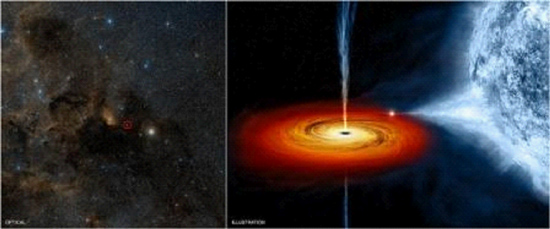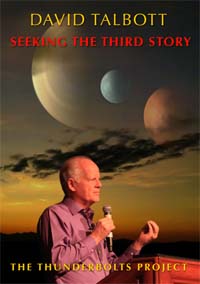
Cygnus X-1: what the telescope sees (left); what the artist sees (right). Credit: Optical: DSS; Illustration: NASA/CXC/M.Weiss
May 21, 2012
Without a theory of electricity in space, astronomers must explain cosmic lightning with theories of falling gas.
To get x-rays from falling gas, the gas must be attracted to a source of gravity with orders-of-magnitude more force than any known density of matter. Nevertheless, with suitable assumptions about the theoretical compressibility of gas, coupled with dividing by zero to allow density to rise without limit, the requisite mass can be attributed to a geometrical point in a relativistic coordinate system.
The relativistic coordinate system provides the equations by which the spread in energy of the x-ray signal can be associated with a rotational speed around the point source. Cygnus X-1 is therefore spinning “more than 800 times a second.”
With such a “blank check” methodology, any mass can be written in to satisfy the requirements for any energy source. These astronomologers will be building a perpetual-motion machine any day!
The same methodology and assumptions can explain how your dentist’s x-ray machine works: A jet of gas—laughing gas, of course—is injected toward a very tiny black hole. As the gas falls toward the event horizon, it emits the burst of x-rays that reveals the cavity in your cognitive choppers. (Apparently, the technology for manufacturing such a tiny black hole has been kept secret.)
Astronomers can’t see the black hole, of course. They can’t even see the event horizon. However, they can see the blue giant companion star, from which they think the gas falls. By analyzing the motion of this companion, they conclude that the black hole has a mass 14.8 times that of the Sun.
With a theory of electricity in space (for example, the one underpinning the Electric Universe), the methodology is reversed: the theory that explains the operation of your dentist’s x-ray machine is adapted to explain the emissions from Cygnus X-1: an electric field accelerates ions in plasma to x-ray energies. When they collide with other atoms, they emit x-rays.
The presence of the blue giant companion is significant. It indicates that the system is under great electrical stress. An expected response to the stress is for an original single star to split into two unequal components in order to spread the discharge out over a greater surface area. The blue giant takes most of the current, radiating from the “anode tuft” arcs in its photosphere. The companion has no photosphere but radiates x-rays from a high-temperature corona. This is the same condition that prevails in the Sirius system, except the x-ray companion in Cygnus X-1 is putting out more power.
But what about the orbit of the blue giant companion? Surely, that requires the mass of the black hole. Let’s not jump to conclusions: no one knows what mass is. It popped up as a ratio in Newton’s equations of motion (f/a), someone with carious cognitive choppers assumed it was the same thing as matter, and astronomers have been choking on the undigested mass ever since. Mass is a property of matter, and there are indications that it varies with the net charge on a body.
The x-ray companion in Cygnus X-1 need not have the quantity of matter of 14.8 Suns, only a comparably high charge.
Mel Acheson
Now Available – Seeking the Third Story DVD

2 Lectures by David Talbott
According to author David Talbott, all of human history can be seen as just two stories.
First, came the story of ancient mythology, when towering gods were said to have ruled the world. Then came the story of science, emerging from a growing distrust of the myths and a new emphasis on direct observation and reason.
But a third story is possible, according to Talbott, one that sees the underlying provocation of the myths in extraordinary electrical events occurring close to the Earth. To be believed, a third story must be more coherent and more meaningful than either archaic religious mythologies or the modern mythologies of popular science.












